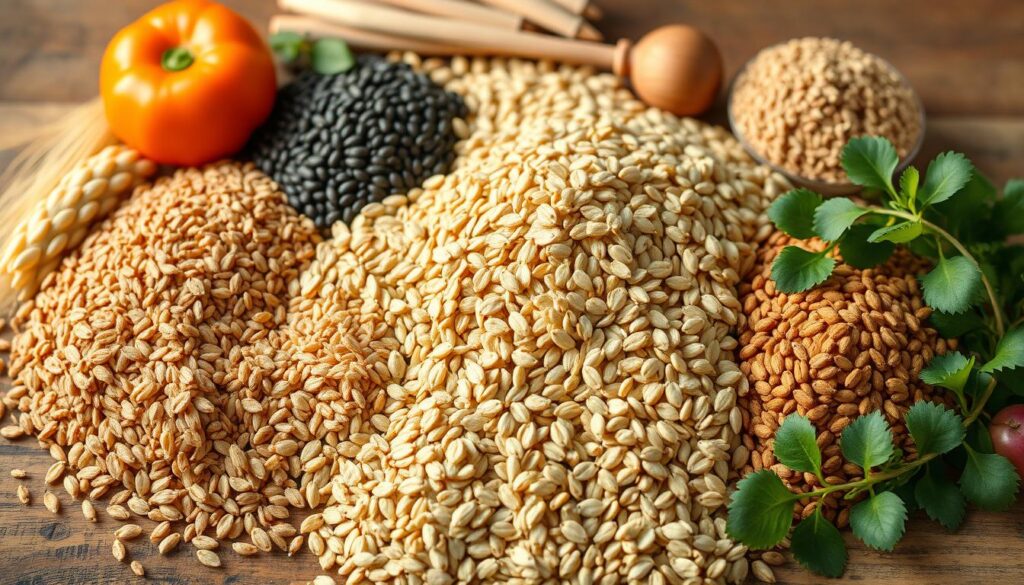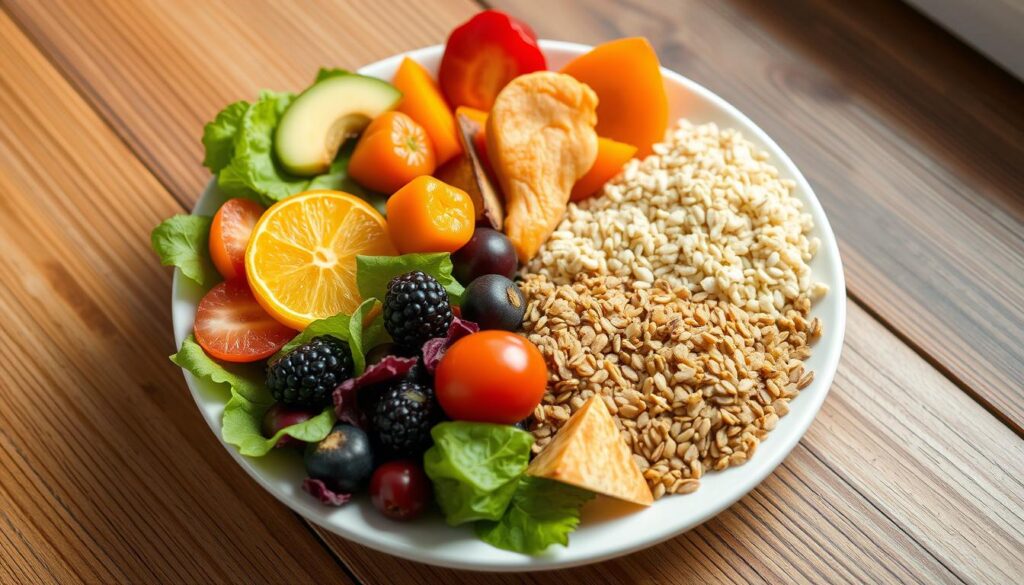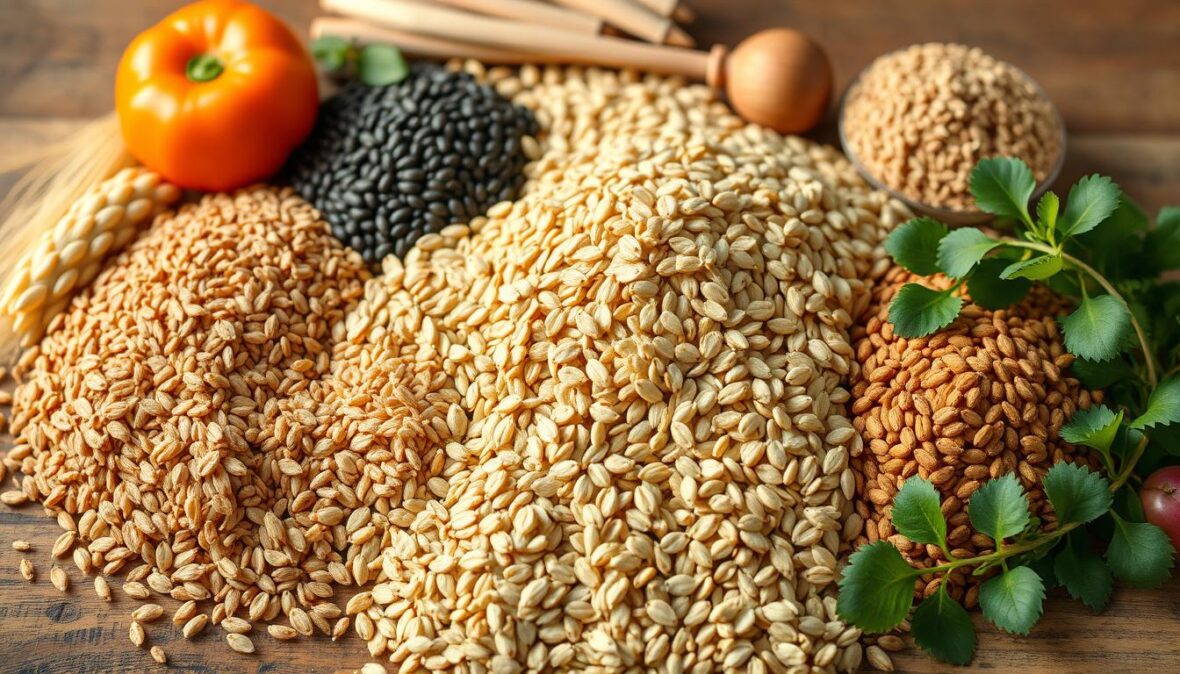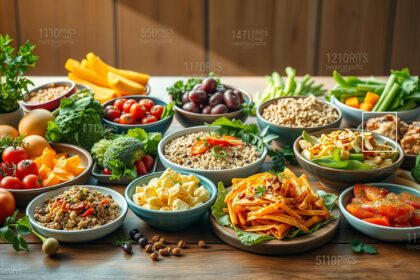A healthy diet is key to feeling good and staying disease-free. The Food and Agriculture Organization (FAO) and World Health Organization (WHO) have set out important eating rules. These rules help us stay healthy and avoid long-term illnesses.
To eat well, we should try different foods, eat lots of fruits and veggies, pick whole grains, and choose good fats. By doing this, we can get better nutrition and lower our risk of serious diseases.

Using these healthy eating tips every day can really boost our health. For instance, eating less saturated fat can stop us from gaining unhealthy weight. Also, cutting down on sugar can help our teeth and keep us at a healthy weight.
Key Takeaways
- Eat a variety of foods for balanced nutrition
- Include plenty of fruits and vegetables in your diet
- Choose whole grains over refined options
- Opt for healthy fats and limit saturated fat intake
- Reduce sugar and salt consumption for better health
- Stay hydrated with water as the primary beverage
- Practice portion control and mindful eating
Understanding the Foundations of Nutritional Health
Learning about nutrition is crucial for a healthy life. Good nutrition helps prevent diseases and boosts overall health. Let’s explore the key aspects of nutritional health and how they impact our lives.
The Role of Balanced Nutrition in Disease Prevention
Eating a balanced diet with lots of fruits and veggies can lower health risks. Research shows eating more of these foods can cut cancer risk by up to 20%. A good diet also keeps your mind sharp and helps you stay at a healthy weight. This is important for avoiding diseases like type 2 diabetes and heart disease.
Defining Sustainable Health Through Diet
Healthy living means making smart food choices every day. The USDA Food Patterns guide us with 12 calorie levels, from 1,000 to 3,200. These levels help meet different nutritional needs. They focus on whole foods and limit processed foods, which often lack nutrients and have harmful additives.
International Guidelines and Standards
Global dietary guidelines emphasize eating a variety of foods. The 2015-2020 Dietary Guidelines for Americans highlight five food groups: Fruits, Vegetables, Grains, Protein Foods, and Dairy. They suggest keeping added sugars and saturated fats under 10% of total calories for better health.
- Eat a variety of foods from all food groups
- Increase fruit and vegetable intake
- Choose whole grains over refined options
- Include lean proteins and healthy fats
- Limit processed foods and added sugars
By sticking to these nutrition principles and guidelines, you can start a healthier lifestyle. Remember, small changes in your diet can make a big difference in your health over time.
What Are the Five Principles of Healthy Nutrition
The key principles of a healthy diet are the foundation for good nutrition. They guide us in making smart food choices. This supports our health and well-being. Let’s look at the five essential principles for balanced meals and a nutritious lifestyle.
Food Variety and Nutrient Adequacy
Eating a wide variety of foods is key to getting all the nutrients your body needs. Each food group has unique benefits. So, mix it up! Include whole grains, colorful vegetables, fruits, and lean proteins.
This variety ensures you get a full range of vitamins, minerals, and other essential nutrients.
Portion Control and Energy Balance
Maintaining a healthy weight is about balance. Watch your portion sizes and match your calorie intake to your energy needs. Keep your total fat intake below 30% of your daily calories, with saturated fats under 10%.
This helps prevent weight gain and reduces the risk of chronic diseases.
Plant-Based Focus
Filling your plate with plant-based foods is a key part of healthy eating. Aim for at least 400g (five portions) of fruits and vegetables daily. These foods are full of fiber, vitamins, and minerals.
They help lower your risk of heart disease, stroke, and certain cancers. Plus, they’re naturally low in calories, making weight management easier.
Limiting Processed Foods
Choosing whole foods over processed ones is a basic principle of healthy eating. Whole foods are closer to their natural state and have more nutrients. They’re often free from added sugars, excess salt, and unhealthy fats.
By limiting processed foods, you can reduce unhealthy components. This boosts your overall nutrition.
By following these principles, you can create a balanced eating plan. This nourishes your body and supports long-term health. Remember, small changes can make a big difference in your well-being.
The Power of Plant-Based Foods in Your Diet
Eating fruit and vegetables is crucial for a healthy lifestyle. The 5 a day rule suggests eating at least five portions of fruit and veg daily. This plant-based approach offers many health benefits and helps the planet.
A diet rich in fruit and veg can lower heart disease risk and help manage weight. Studies show people who eat more plants tend to weigh less. Those on plant-based diets lost an average of 4.5 pounds over 18 weeks compared to non-vegetarian diets.
Fruit juice counts as one of your 5 a day, but limit it to a small glass. Whole fruits and vegetables are better choices as they contain more fiber. Aim for a variety of colors on your plate to get different nutrients.
| Food Group | Daily Servings | Benefits |
|---|---|---|
| Vegetables | 4-5 | Rich in vitamins, minerals, and fiber |
| Fruits | 2-3 | Provides antioxidants and natural sweetness |
| Whole Grains | 3-4 | Offers sustained energy and B vitamins |
| Legumes | 1-2 | Excellent source of plant protein and fiber |
By shifting to a more plant-based diet, you’re not just improving your health. You’re also helping the environment. Studies suggest this change could lead to a 70% reduction in greenhouse gas emissions from food production. Start small by adding an extra serving of fruit or veg to your meals each day.
Smart Carbohydrate Choices for Sustained Energy
Carbohydrates are key in our diet, giving us energy. They help with workouts, brain function, and weight control. Choosing the right carbs is crucial for health and energy.
Choosing Whole Grains Over Refined Options
Whole grains are packed with nutrients. Foods like brown rice, quinoa, and Ezekiel bread are better than refined ones. They keep blood sugar stable.

Fiber-Rich Foods and Their Benefits
Organic berries, sweet potatoes, and squash are great choices. They boost digestion, offer antioxidants, and keep you full. Beans and lentils add fiber and protein, making meals balanced.
Balancing Starchy Foods in Meals
Starchy foods can be healthy if balanced. Long grain white rice, for example, has a lower glycemic index. Mixing starchy foods with proteins and veggies makes meals that last.
| Carbohydrate Source | Benefits | Best Use |
|---|---|---|
| Whole grains (brown rice, wholegrain bread) | Rich in fiber, vitamins, and minerals | Daily meals, pre-workout |
| Sweet potatoes | High in antioxidants, supports immune function | Post-workout recovery |
| Quinoa | Complete plant protein, gluten-free | Versatile for any meal |
| Berries | Antioxidants, low glycemic impact | Snacks, breakfast addition |
Essential Protein Sources and Healthy Fats
A balanced diet is key. It includes protein and healthy fats. Protein builds muscles and repairs tissues. Healthy fats are good for the heart. Let’s look at important sources and their benefits.
Fish and Omega-3 Benefits
Fish is a top protein source. Oily fish like salmon and sardines have lots of omega-3s. These fats are great for the heart. Aim to eat fish twice a week, with oily fish as one option.
Plant-Based Protein Options
Beans, lentils, and nuts are great for those who don’t eat meat. They’re full of protein and fiber. Soy products like tofu are also good, as they have all the amino acids you need.
Understanding Different Types of Fats
Not all fats are the same. Unsaturated fats are better than saturated fats. Here are some good sources:
- Avocados
- Nuts and seeds
- Olive oil
- Fatty fish
| Nutrient | Daily Calorie Intake | Good Sources |
|---|---|---|
| Protein | 10-30% | Fish, beans, nuts, lean meats |
| Healthy Fats | 20-35% | Avocados, olive oil, fatty fish |
| Carbohydrates | 45-65% | Whole grains, fruits, vegetables |
Make sure to mix protein and healthy fats in your meals. This mix is good for your health and can help prevent heart disease. But remember, even healthy fats should be eaten in moderation.
Managing Sugar and Salt Intake
Eating less sugar and salt can help avoid many health issues. The World Health Organization recommends free sugars should be under 10% of daily calories. For even better health, aim for less than 5%. Salt intake should be below 5g per day.
Too much sugar and salt can cause weight gain, diabetes, and high blood pressure. Here are some tips to eat less of these:
- Check food labels for hidden sugars and salt
- Choose fresh foods over processed ones
- Cook meals at home to control ingredients
- Use spices and herbs instead of salt for flavor
Here’s a quick guide to help you manage your sugar and salt intake:
| Nutrient | Daily Limit | Tips to Reduce |
|---|---|---|
| Sugar | Less than 50g (12 teaspoons) | Drink water instead of sugary drinks |
| Salt | Less than 5g (1 teaspoon) | Rinse canned vegetables to remove excess salt |
By following these guidelines, you can improve your diet and protect your health. Remember, small changes can make a big difference in managing your sugar and salt intake.
Hydration Guidelines for Optimal Health
Drinking enough water is crucial for your health. Most adults need 6 to 8 cups of fluid every day. Water is the best choice, but other drinks like milk and juice also count.
Daily Water Requirements
Your body needs water to work right. Adults should aim for 6-8 glasses of fluid each day. Kids need water and milk to grow strong.
Pregnant women should watch their caffeine intake, limiting it to 200mg daily.
Healthy Beverage Choices
Water is the best drink for staying hydrated. Low-fat milk and sugar-free drinks also help meet your daily fluid needs. Limit fruit juice to 150ml per day because it has a lot of sugar.
For kids, water and milk are best. They help avoid extra sugar and weight gain.
Understanding Hydration Timing
Drink extra fluids when you sweat from exercise or feel sick. Your body loses more water at these times. Water is great for rehydrating.
Pay attention to your thirst and drink up!
| Age Group | Water Content in Body | Recommended Fluids |
|---|---|---|
| Infants | 75% | Breast milk or formula |
| Children | 65-70% | Water, milk |
| Adults | 60-65% | Water, low-fat milk, sugar-free drinks |
| Elderly | 55% | Water, milk, hydrating foods |
The Role of Portion Control and Meal Timing
Mastering portion control is key to a healthy weight and managing energy intake. Understanding serving sizes helps balance calories and feel full without overeating.
Understanding Serving Sizes
Knowing proper serving sizes is crucial for portion control. Use a food scale or measuring cups to assess your intake. Research shows that people tend to eat more from larger packages, with one study finding an increase of nearly 12% in food consumption.

Meal Frequency and Timing
The timing of your meals can impact your energy intake. Starting a meal with water can increase feelings of fullness. Eating slowly also helps – research suggests that eating quickly may be linked to higher body weight and BMI.
Mindful Eating Practices
Practice mindful eating to better control your portions. Pay attention to hunger and fullness cues. Keep a food diary to increase awareness of your eating habits. This can help you make healthier choices and manage your daily calorie intake more effectively.
- Use smaller plates to control portions
- Eat slowly and savor your food
- Listen to your body’s hunger signals
- Avoid distractions while eating
By implementing these strategies, you can better manage your portion sizes, feel full, and maintain a healthy energy intake throughout the day.
Creating Balanced Meals Using the Healthy Plate Model
The healthy eating plate is a simple yet powerful tool for building a balanced diet. It helps you create nutritious meals that support overall health and well-being. Let’s explore how to use this model effectively.
The healthy plate model divides your meal into sections, each representing different food groups. Here’s a breakdown of the recommended portions:
- Vegetables and fruits: 50% of your plate
- Whole grains: 25% of your plate
- Healthy proteins: 25% of your plate
This approach aligns with the eatwell guide, promoting a variety of nutrient-rich foods. By following these proportions, you can easily create a healthy balanced diet that meets your nutritional needs.
| Food Group | Daily Recommendation | Examples |
|---|---|---|
| Fruits | 2 cups | Apples, berries, oranges |
| Vegetables | 2.5 cups | Leafy greens, carrots, broccoli |
| Grains | 6 ounces (half whole grains) | Brown rice, whole wheat bread |
| Protein | 5.5 ounces | Fish, poultry, beans, nuts |
| Dairy | 3 cups | Milk, yogurt, cheese |
Remember, the healthy eating plate is flexible. You can adapt it to various cuisines and dietary preferences while maintaining balance. By using this model, you’ll be on your way to creating nutritious, satisfying meals that support your health goals.
Special Dietary Considerations and Flexibility
Healthy eating isn’t a one-size-fits-all deal. It’s about finding what works for you and staying open to change. Let’s look at how to adjust nutrition to fit different needs and tastes.
Cultural Food Preferences
Every culture has its own food traditions. The trick is to mix these traditions with balanced eating. For example, a balanced vegetarian diet can be as healthy as one with meat. It’s about making smart choices that fit your culture.
Dietary Restrictions and Alternatives
Many people have dietary restrictions due to allergies, intolerances, or personal choice. The good news? There are always options. If you’re lactose intolerant, try calcium-fortified plant milks. Gluten-free? Quinoa and rice are great choices.
Age-Specific Nutritional Needs
Our nutritional needs change as we age. Kids need more calcium for growing bones, while older adults might need more vitamin D. Clinical nutrition experts can help create diets that meet these needs.
| Age Group | Key Nutritional Focus | Recommended Daily Intake |
|---|---|---|
| Children (4-8 years) | Calcium | 1000 mg |
| Teens (14-18 years) | Iron | 15 mg (girls), 11 mg (boys) |
| Adults (19-50 years) | Vitamin D | 600 IU |
| Seniors (51+ years) | Vitamin B12 | 2.4 mcg |
Remember, being flexible is key. The 5 Factor Diet, for example, suggests five small meals a day, each with five ingredients. This method can be adjusted to fit various dietary needs while keeping nutrition balanced.
Conclusion
Starting your journey to better health today is easy. Just learn and use key nutrition principles for a healthy lifestyle. The five main principles of healthy eating guide you to improve your health and lower disease risks.
Eating whole foods is key to better health. Studies show diets full of whole foods help with weight and health. Eating a variety of plant-based foods, whole grains, and staying hydrated is crucial.
Changing for the better is about small, steady steps, not big jumps. Only 12% keep weight off after trying fad diets. Eating balanced meals and keeping regular eating times helps control hunger and fullness.
Remember, improving your health is a journey, not a quick fix. Small, consistent changes can make a big difference in your health and happiness.



